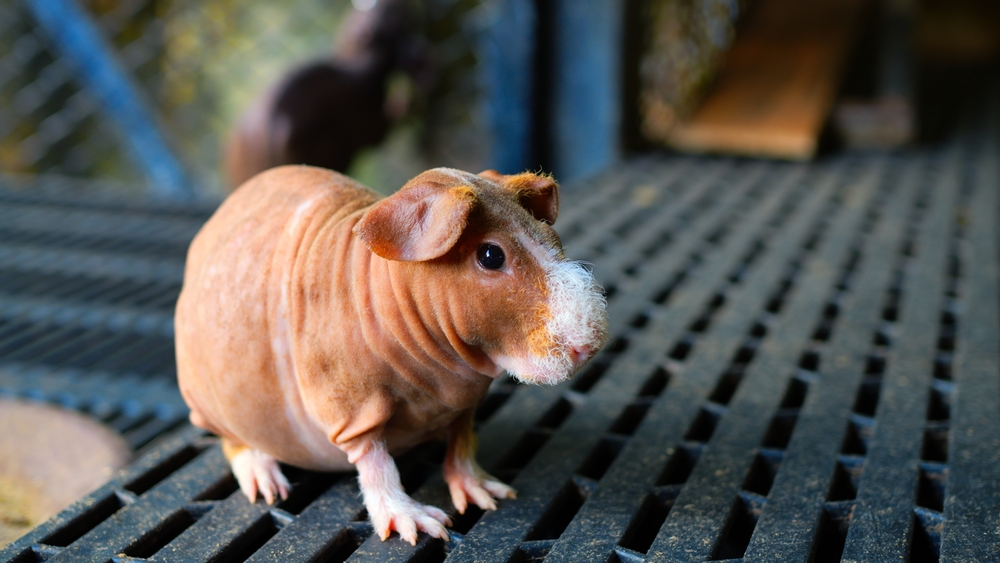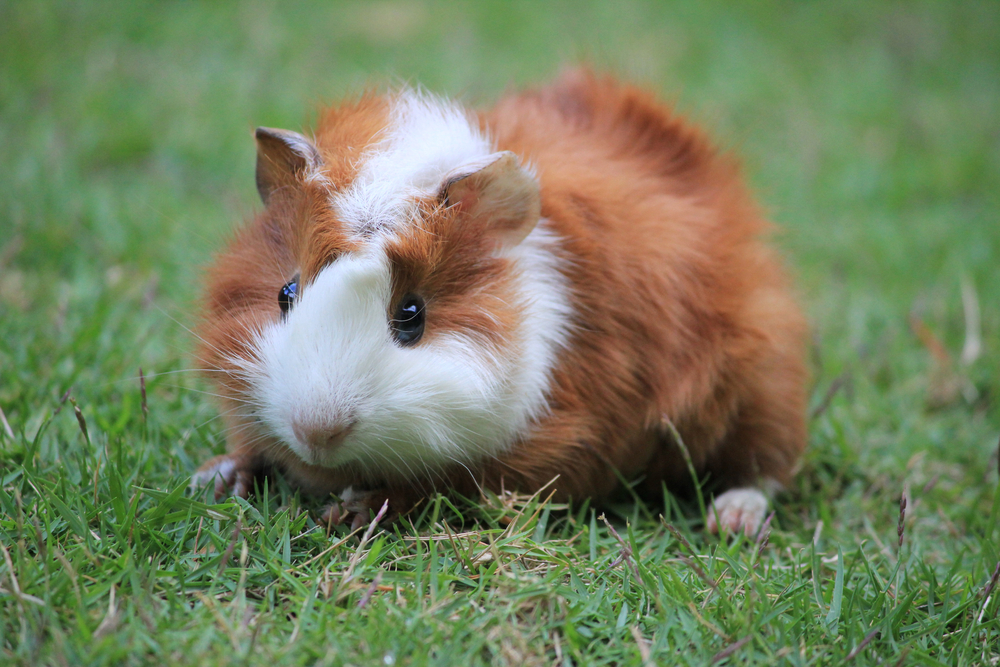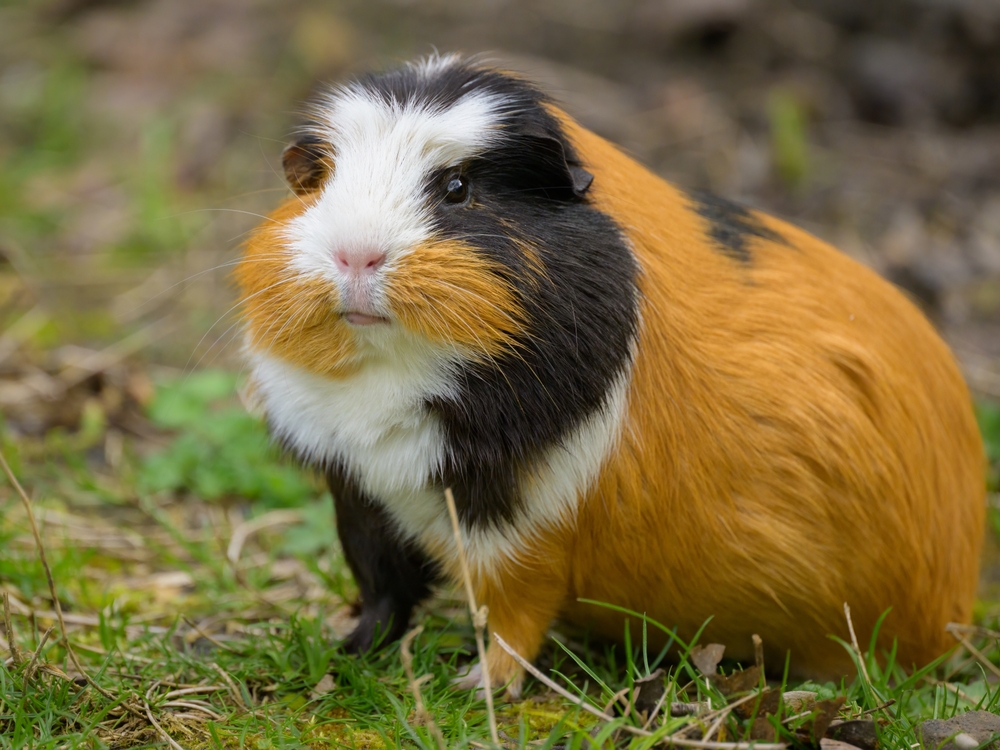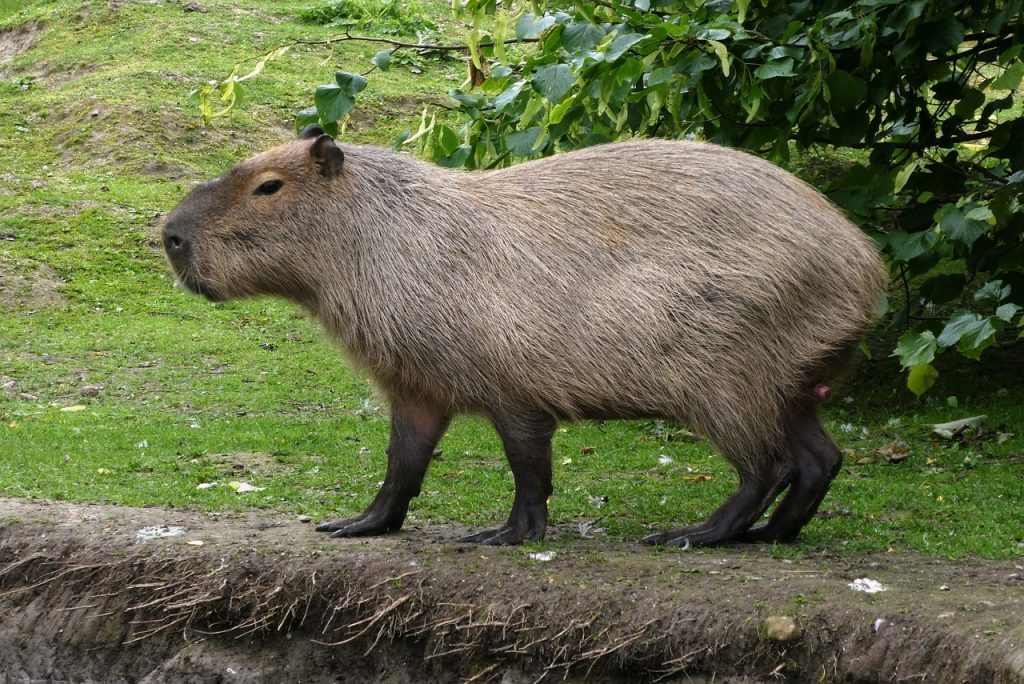The closest species to the Hairless Guinea Pig is the domestic guinea pig (Cavia porcellus). Hairless guinea pigs are not a separate wild species, but rather a selectively bred variety of domestic guinea pigs, sharing the same ancestry as their furred relatives.
About
The Hairless Guinea Pig, commonly called the Skinny Pig, is a domestic breed recognized for its nearly bald body and distinctive appearance. Unlike their fully furred relatives, Hairless Guinea Pigs display mostly bare, wrinkled skin with small tufts of fine hair often found on the muzzle, feet, and sometimes shoulders. Their skin can vary in color from pink to black and may be solid or patterned. Because they lack the insulating coat of other guinea pigs, they require warmer environments and careful protection from cold drafts or harsh sunlight.
Social, vocal, and gentle, Hairless Guinea Pigs are beloved for their affectionate personalities and are best kept in pairs or groups to prevent loneliness. Their need for companionship and daily interaction makes them ideal for owners who can dedicate time and attention. These animals are strict herbivores, thriving on a diet of hay, fresh vegetables, fortified pellets, and supplemental vitamin C. They share the same reproductive cycle as other guinea pigs, with a gestation period of around 60–70 days and litters of 2–4 pups born precocial, meaning fully developed and mobile.
The Hairless Guinea Pig is not a separate species but a distinct breed of the domestic guinea pig. Its scientific name is Cavia porcellus, and it belongs to the family Caviidae, which also includes cavies, maras, and other related rodents of South America. With proper care, Hairless Guinea Pigs typically live 4–6 years, though some may reach 7 or more. Their unique look, gentle temperament, and interactive nature have made them increasingly popular as exotic pets worldwide, even though they do not exist in wild habitats or national parks.
Physical Characteristics
Hairless guinea pigs, also known as “skinny pigs,” are distinct for their nearly bald appearance:
Coat:
Unlike typical guinea pigs, hairless guinea pigs lack most fur, with only sparse patches of short hair often found on the muzzle, feet, and legs. Their exposed skin can be wrinkled and comes in a variety of colors and patterns, including solid, spotted, or patched tones.
Face:
They have a broad, rounded head with large, expressive eyes and prominent ears. The whiskers may be sparse or absent, adding to their unique look.
Body:
Their bodies are cylindrical and compact, with skin folds that highlight their nearly naked form. The lack of insulating fur makes them more sensitive to temperature fluctuations than furred guinea pigs.
Size:
-
Length (Body): 8 to 12 in (20 to 30 cm)
-
Shoulder Height: Approximately 4 to 5 in (10 to 13 cm)
Weight:
-
Adult hairless guinea pigs generally weigh between 1.5 to 2.5 lbs (700 to 1,100 g).
Hairless guinea pigs’ physical traits, particularly their exposed skin, make them more dependent on controlled environments. They require warmth, protection from direct sunlight, and proper care to maintain healthy skin.
Reproduction
The reproductive cycle of hairless guinea pigs is similar to that of other guinea pig breeds, with adaptations to ensure the survival of their nearly furless offspring.
1. Mating and Courtship:
Hairless guinea pigs are social animals and breed readily when males (boars) and females (sows) are kept together. Courtship involves vocalizations, gentle nudging, and circling. They can breed year-round.
2. Gestation:
The gestation period lasts about 59 to 72 days, averaging 68 days, which is relatively long for small rodents.
3. Birth of Pups:
Litters typically consist of 1 to 6 pups, with an average of 3 to 4. Unlike many small mammals, guinea pig pups are born precocial—fully furred (or in the case of hairless, skin-exposed with some patches), eyes open, and able to move shortly after birth.
4. Care and Nurturing:
Pups are born with teeth and are capable of nibbling solid food within hours, though they rely on the mother’s milk during their first weeks. Hairless pups may need extra warmth since they lack fur for insulation.
5. Weaning and Growth:
Weaning usually occurs at 3 weeks of age, when the pups can eat solid food independently. Males are often separated from females at this stage to prevent early breeding.
6. Independence and Maturity:
Hairless guinea pigs reach sexual maturity quickly:
-
Females: as early as 4 weeks of age
-
Males: around 8 to 10 weeks of age
Early maturity means controlled breeding management is essential to avoid health risks in young mothers.
The reproductive strategy of hairless guinea pigs ensures relatively high survival chances for pups by producing them in a well-developed state. However, due to their lack of fur, both mothers and pups require attentive care and stable environments for healthy development.
Lifespan
Hairless guinea pigs, often called skinny pigs, have a life expectancy that reflects both their unique care needs and environmental conditions.
Lifespan in the Wild (Not Applicable):
Hairless guinea pigs are a domesticated breed and do not occur naturally in the wild. They were developed through selective breeding and rely on human care for survival.
Lifespan in Captivity:
In well-cared-for environments, hairless guinea pigs typically live 5 to 7 years, though some may reach up to 8 yearswith excellent diet and veterinary care. Their lifespan is slightly shorter on average than that of furred guinea pigs, largely due to their increased sensitivity to temperature changes, skin health issues, and greater energy requirements.
Threats to the Hairless Guinea Pig:
-
Temperature Sensitivity: Without fur, they are vulnerable to cold drafts and extreme heat, requiring a stable, warm environment.
-
Skin Issues: Their exposed skin is prone to dryness, irritation, or injury and must be monitored closely.
-
Dietary Needs: Higher metabolic demands require a nutrient-rich diet, especially with ample vitamin C to prevent deficiencies.
-
Genetic Factors: As a selectively bred variety, some individuals may inherit weaker constitutions, which can affect longevity.
Care and Protection:
Providing a consistent, warm living environment, balanced diet, regular veterinary checkups, and gentle handling are essential to maximizing the lifespan of hairless guinea pigs. With attentive care, they can live long, healthy lives as affectionate companion animals.
Eating Habits
Hairless guinea pigs are herbivores with specialized dietary needs that support their higher metabolism and lack of insulating fur.
Diet:
Their diet consists mainly of hay, which provides essential fiber for digestion and helps wear down constantly growing teeth. They also require fresh vegetables and leafy greens daily, with a particular emphasis on foods rich in vitamin Csuch as bell peppers, kale, or parsley, since guinea pigs cannot synthesize this vitamin on their own. Limited amounts of fresh fruit can be offered as treats. Commercial guinea pig pellets fortified with vitamin C are also an important dietary component.
Feeding Behavior:
Hairless guinea pigs graze frequently throughout the day, nibbling almost constantly. Because of their higher metabolic rate and the absence of fur, they burn energy more quickly and need slightly more food than furred guinea pigs.
Special Considerations:
-
Vitamin C: Deficiency leads to scurvy, a serious health risk, so daily supplementation through food or pellets is vital.
-
Hydration: Fresh, clean water must always be available.
-
Sensitivity: They are prone to digestive upset if introduced to new foods too quickly, so diet changes should be gradual.
Social Eating:
As social animals, hairless guinea pigs often eat together in groups, which helps reduce stress and encourages healthy feeding behavior.
Hairless guinea pigs’ eating habits reflect both their natural grazing instincts and their unique physical needs. Providing a nutrient-rich, vitamin C–fortified diet ensures their health and supports their energy demands.
Uniqueness
The hairless guinea pig, often called the “skinny pig,” is a remarkable companion animal with several distinctive traits that set it apart from other guinea pig breeds.
Nearly Hairless Appearance:
The most striking feature is its lack of fur, with only small patches of fine hair around the nose, feet, and legs. Their exposed skin can display a wide range of colors and patterns, making each individual visually unique.
Selective Breeding Origins:
Hairless guinea pigs were first developed in the 1970s through selective breeding and are fully domesticated. They do not exist in the wild and rely entirely on human care.
High Metabolism:
Because they lack fur, they lose heat more quickly than their furry counterparts. This results in a higher metabolism and the need for slightly more food to maintain body temperature and energy levels.
Sensitive Skin:
Their bare skin is delicate and prone to dryness, irritation, or sunburn. Owners must provide protection from drafts, harsh sunlight, and rough surfaces.
Social and Vocal:
Like other guinea pigs, they are highly social and communicate through a variety of vocalizations such as squeaks, chirps, and purr-like sounds. Their friendly nature and expressive calls make them engaging pets.
Special Care Requirements:
They require warmer living environments and consistent handling to ensure comfort and well-being. Their unique appearance and care needs make them stand out as both charming and distinctive among small companion animals.
Hairless guinea pigs’ combination of appearance, higher energy demands, and sensitive care requirements makes them one of the most unusual and endearing varieties of guinea pigs.
Be the First to Share Photos of This Species.
FAQ’s
1. What is the closest species to the Hairless Guinea Pig?
2. How does the Hairless Guinea Pig compare to other guinea pigs?
Hairless guinea pigs differ from other guinea pigs primarily in appearance and care needs. Unlike furred breeds, they have little to no coat, exposing wrinkled skin.
This makes them more sensitive to temperature changes and gives them a slightly higher metabolism, requiring more food. They are otherwise similar in size, reproduction, diet, and social behavior to other guinea pig breeds.
3. What national parks provide the best chance to see a Hairless Guinea Pig?
Hairless guinea pigs are a domesticated breed and are not found in the wild or in national parks. They can only be seen in captivity, such as in homes, research facilities, or specialty breeders.
For guinea pigs in their natural habitat, travelers would need to visit regions of South America, particularly the Andes, where wild relatives like the montane guinea pig (Cavia tschudii) still live.






































































